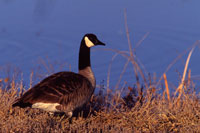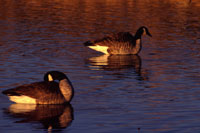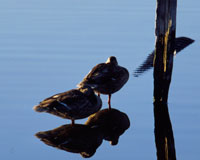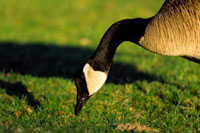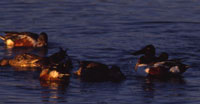The bird guide reveals their identity with descriptions like “a distinctive white chin strap” and “slender, elongated neck.” The familiar “ah-honk!” separates these creatures from their lowly waterfowl relatives the scaups and shovelers, mallards and mergansers. Often referred to as “honkers,” Canada geese are a conspicuous component of the spring fauna here in the desert.
But not everyone is thrilled with these birds. Recent population explosions have them on the Rodney Dangerfield list of “they don’t get no respect.” Pursued in parks and swung at on golf courses, Canada geese populations have rebounded after plummeting during the early 20th century. Conservation groups and government organizations intervened, but they never thought the numbers would soar like they did.
However, the 6 to 8 subspecies, depending upon your taxonomic views, have responded differently. Some are doing well, others not so.
Spring Nesting
But we have to give the geese some “cred”, as my hipster friend would say. In Canyon Country, the geese take to laying eggs early in the season on sandbars and isolated river islands, hoping to get through the incubation period prior to the rising of the river. “We ain’t no wood ducks,” the ground nesters cackle.
But not so fast. Row down the Colorado River through Ruby/Horsethief Canyon just above the Utah/Colorado state line and you might encounter the “Cliff Nesting Geese of Colorado.” In a section of the canyon that is pockmarked with large sandstone cavities, these geese have taken their egg laying to new heights. Literally.
Even though most of the neotropical migrants have not yet returned to Canyon Country from their more-southern wintering grounds, the resident geese have been hard at it. Their nesting season starts early and they have been sitting on eggs through this tough, late winter.
During the nesting season, the male, also known as the gander, guards the incubating female. Stumble upon a nesting pair and the male may charge or fly at the intruder. Using its bill and wings, the male takes his territorial duties seriously.
The average clutch size for a Canada goose varies from region to region. The Utah Division of Wildlife Resources estimates an average clutch to be 4 to 7 eggs. Not huge, but enough to sustain the population with a significant mortality rate.
With the attentive male nearby, the female alone incubates the eggs for about a month. By April, goslings may appear and resemble rubber duckies as they line out between their parents, swimming across the water.
But where there are young, there are also bound to be predators. An adult goose is a formidable foe, but an immature one is short on experience. Vigilance, tactics, and warning signs are new traits in the development stage, so the numbers dwindle.
Yet the young are not totally defenseless. Even day-old young can swim and dive up to 40 feet underwater. The young bulk up and may gain about a pound a week for the first eight weeks and before they are ready to fly.
Gaggles and Skeins
During the nesting season the geese form solitary pairs, defending their territories. As the young grow older, family groups come together and form flocks. On the ground they are known as “gaggles.”
Later on in the season, after the summer molt, some of the geese migrate. The large V-formations of birds are a sight to behold. Known as “skeins,” these flocks stretch across the sky, the honks echoing their passage.
But now it is a pleasure to see and hear these harbingers of spring as the birds move up and down along the Colorado River.

